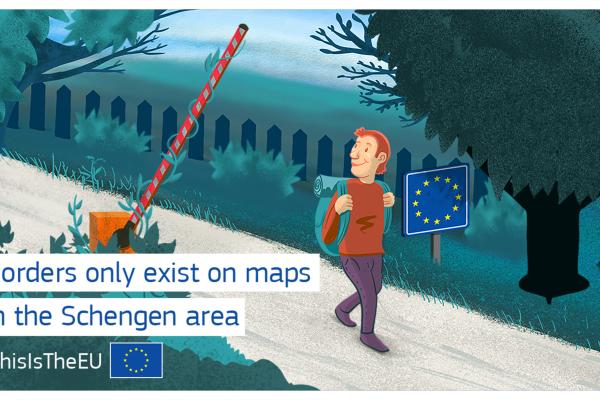EU citizens, non-EU residents and visitors to the EU need to be able to freely and safely travel within the EU. The Schengen Area has made this a concrete reality.
The Schengen Area is one of the greatest achievements of the EU. It is an area without internal borders, an area within which citizens and many non-EU nationals staying legally in the EU can freely circulate without being subjected to border checks. Since 1985, it has gradually grown and encompasses almost all EU Member States and a few associated non-EU countries.
While having abolished their internal borders, Schengen countries have also tightened controls at their common external border on the basis of common Schengen rules to ensure the security of those living or travelling within the Schengen Area.

The Schengen area is an area without internal borders, where EU citizens, non-EU residents and visitors can travel safely and freely.

The EU has a common list of countries whose citizens must have a Schengen visa for entering the EU, and a list of countries whose citizens are exempt from that requirement.

EU countries work together to secure EU’s external borders. Common rules apply for border checks and EU short-stay visas.

Every year millions of travellers from third countries cross the external borders of the Schengen States and estimations point to ever-increasing traveller flows.

The Visa Information System (VIS) collects, processes and shares information relevant to external border management among EU countries.

The Schengen Information System (SIS) is an information sharing system for security and border management in the EU.
Effective management of EU external borders is a key element for a Schengen area without internal border checks.
The security of documents used for travel purposes or as a proof of identity is essential. Advanced security features and biometrics (facial image and fingerprints) help fight against counterfeiting.
The EU uses large-scale IT systems at its external borders. Interoperability aims to allow good data management between the Union’s IT systems in the field of borders, visa, police and judicial cooperation, asylum and migration.
A single set of rules for external border checks on persons
The Schengen Borders Code governs the crossing of the external border, facilitating access for those who have a legitimate interest to enter into the EU. A common visa policy provides common rules on legal entry to the EU for a short stay (up to 90 days). For non-EU border residents who frequently need to cross the EU external border, a special Local Border Traffic Regime has been established.
Security for citizens and travellers
EU State authorities need to cooperate on border management to ensure the security of citizens and travellers in the EU. A number of information sharing mechanisms are central to this cooperation.
- The Visa Information System (VIS) allows Schengen States to exchange visa data, in particular data on decisions relating to short-stay visa applications.
- The Schengen Information System (SIS) allows Schengen States to exchange data on suspected criminals, on people who may not have the right to enter into or stay in the EU, on missing persons and on stolen, misappropriated or lost property.
VIS and SIS, as well as EURODAC are operated by the EU Agency for large-scale IT systems (eu-LISA).
Two additional information systems are on track to start operating:
- the Entry/Exit System (EES), (which is an automated IT system for the registration of travellers from third-countries), in the second half of 2024;
- the European Travel Information and Authorisation System (ETIAS), (an IT system for the identification of security, irregular migration or high epidemic risks posed by visa-exempt visitors), in the first half of 2025.
Integration of the new complete IT architecture, that will enable a more systematic exchange of information to law enforcement officers, border guards and migration officials, and contribute to fighting identity fraud, will be implemented.
It is also necessary to ensure the security of travel documents to establish a reliable link between the document and its holder and to fight against the falsification and counterfeiting of travel documents.

The aim of the fact-finding mission was to provide recent and additional information on Romania’s and Bulgaria’s implementation of visa policy, data protection and judicial cooperation in criminal matters.

The Commission has called upon the Council to take the necessary decisions without any further delay to allow Bulgaria, Romania and Croatia to fully participate in the Schengen area.

Today, the Commission presented updated guidelines for EU countries on visa procedures and border controls for Russian citizens at the EU's external borders. Based on the guidelines, EU countries should practice greater security scrutiny when issuing visas to Russians and heightened border controls.

